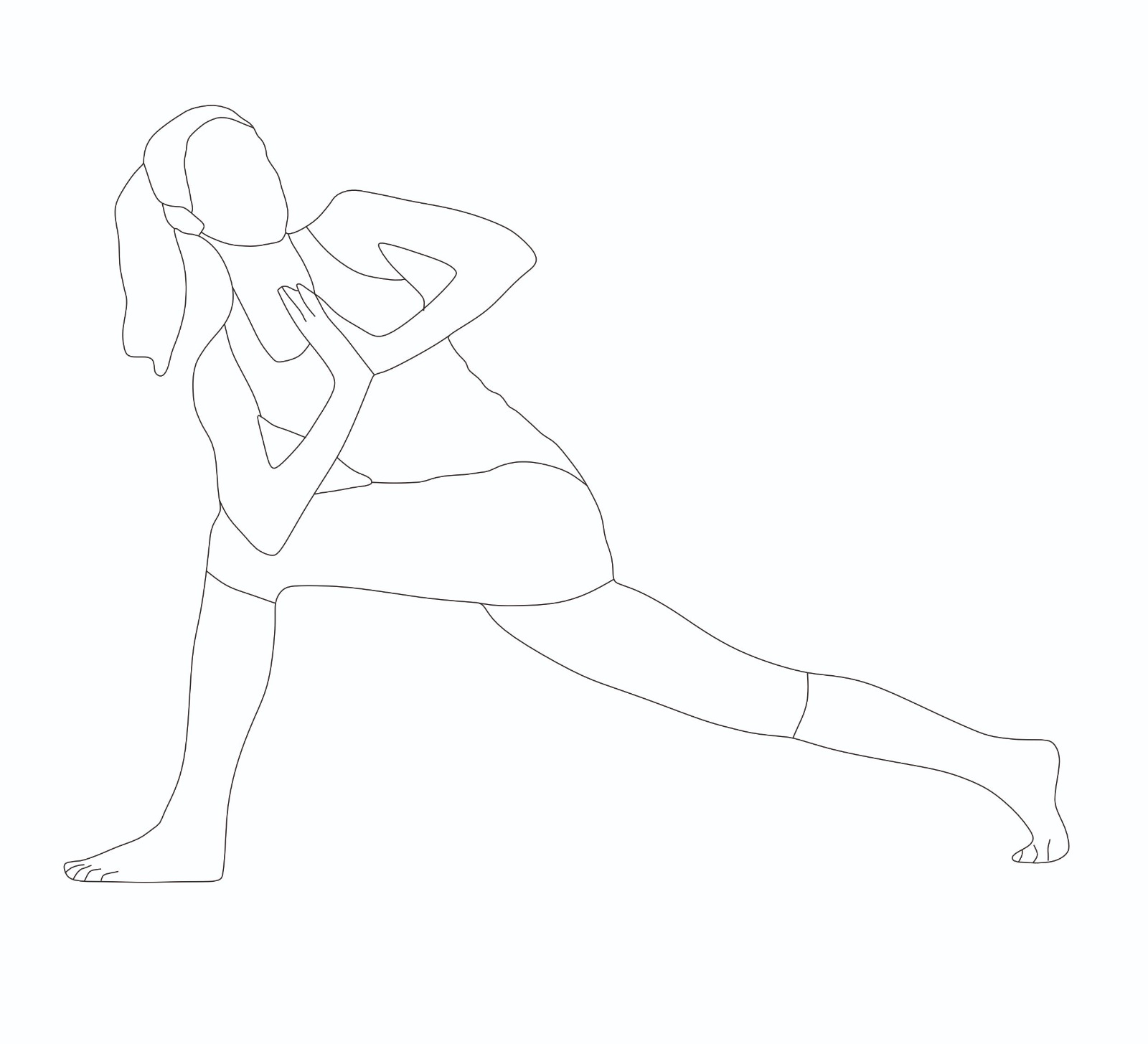Revolved Side Angle Pose (Parivrtta Parsvakonasana) is a powerful twisting yoga of spiral or coil, which requires flexibility, strength and balance. Intense twisting yoga like this helps to detoxify the body and liver. In Sanskrit, it is known as Parivrtta Parsvakonasana (par-ee-VRT-tah parsh-vah-cone-AHS-anna) wherein parivrtta means ‘revolved’, parsva means ‘side or flank’, kona indicates ‘angle’, and asana means ‘pose’. The twisting yoga targets the upper body.

Benefits
It helps to improve digestion as it massages the abdominal organs.
Relieves constipation by stimulating your digestive process.
It is beneficial in the management of low backache and sciatica.
It gives suitable stretching and strengthening to the legs, knees, ankles and spine.
Revolved Side Angle Pose instructions
- Starting Position: Begin in Downward-Facing Dog (Adho Mukha Svanasana). From here, step your left foot forward to a lunge position. Square your hips toward the front of your mat.
- Leg Alignment: Ensure your left knee is bent at a 90-degree angle, with the centre of your kneecap aligned with the centre of your right ankle. Ideally, try to bring your right thigh parallel to the floor.
- Warrior I Transition: Inhale as you lift your torso and raise your arms overhead, transitioning into Warrior I (Virabhadrasana I). Reach your arms toward the sky, creating space in your torso by lengthening the distance between your hip points and armpits. Take several deep breaths in this position.
- Hands in Prayer Pose: Lower your arms and bring your palms together in Anjali Mudra (Prayer Pose), with your thumbs touching your breastbone.
- Twisting Action: Twist your torso to the left, bringing your right elbow to the outside of your left knee. Please make sure your hands are in prayer position throughout this movement.
- Hand Placement: Place your left hand on the floor or a yoga block, pressing your left arm into the outside of your left knee for support. You can reach your right arm straight toward the ceiling or extend it over your right ear with your palm facing the floor. Work on getting your back heel on the floor, although it may not reach there immediately.
- Breathing and Lengthening: Breathe deeply and consciously. Inhale to lengthen your spine, create space, and exhale to deepen the twist. Focus on extending your spine with each inhalation while twisting more with each exhalation. Soften your belly as you lengthen.
- Hold the Pose: Stay in this Revolved Side Angle Pose for 5 to 10 breaths, maintaining your alignment and breathing rhythm.
- Transition Out: Place your back heel down on the mat if it isn’t already there to exit the pose. Lift out of the carriage by using your left arm for support. Then, release the twist and return to a neutral position.
10. Repeat on the Other Side: Inhale as you come up, exhale to release the twist. Reverse your feet and repeat the same sequence on the opposite side.
Variations and Modifications
These variations offer different levels of support, allowing practitioners of various skill levels to benefit from the Revolved Side Angle pose while maintaining balance and alignment. While practising this yoga pose, try to engage your core muscles to enhance stability.
Variation 1: Revolved Side Angle with a Block
You can start in a lunge position with your right foot forward.
Bend your right knee at a 90-degree angle and place a yoga block inside your bent right knee.
You can place your left hand on the block for support as you twist to the right.
You can rest your right hand on your heart or hip.
I want you to please maintain your balance as you twist and keep your hips level and pointed forward.
Variation 2: Bent Knee Revolved Side Angle Pose
You can begin in a lunge position, but this time, you can place your back knee on a mat or a folded blanket for added support.
Please make sure that your front knee stays stacked over your front ankle.
You can keep your hip points level and facing forward as you twist in the pose.
Variation 3: Revolved Side Angle with a Chair
You can use a chair to help maintain balance and leverage the twist.
You can start with your right foot forward, like in a lunge position.
As you twist to the right, place your left hand on the back of the chair or lean forward and support yourself on the chair seat.
Your right hand can rest on your sacrum (the lower part of your spine) to remind you to keep your hips parallel and facing forward.
Preparatory poses
Low Lunge
High Lunge
Extended Side Angle Pose
Half Lord of the Fishes Pose
Bharadvaja’s Twist
Follow up poses
Standing Forward Bend
Downward-Facing Dog Pose
Precautions and Contraindications
While practising the pose, I need to take care of the following safety measures.
You can avoid it if someone has a neck, back, or shoulder injury.
People with high or low blood pressure should skip it.
Pregnant mothers shouldn’t practice it.
You can avoid the pose when you have diarrhoea.
Stop doing the pose if someone feels discomfort beyond regular stretching.
Initially, hold it for three to five breaths and may increase up to 10 breaths with practice.
